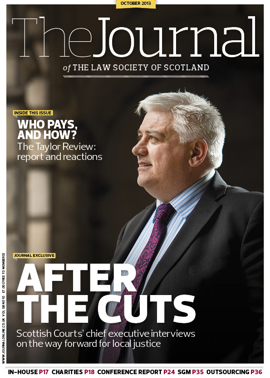All the permutations

Multiple charges
A few years ago there were complaints from the judiciary about the proliferation of charges on indictments, as the Crown sought to cover every possibility in a drugs case, or draw exceptional latitude in historical cases where the incidents overlapped changes in the statutory law or took complainers into the ambit of a different offence.
Section 288BB of the Criminal Procedure (Scotland) Act 1995 was introduced by the Criminal Justice and Licensing (Scotland) Act 2010 to “simplify” charges by enabling several offences to be covered simultaneously.
Afzal v HM Advocate [2013] HCJAC 103 (12 September 2013) deals with some of these issues in relation to a charge of indecent assault and rape which occurred in May 2010, prior to the commencement of the Sexual Offences (Scotland) Act 2009 in December 2010.
The standard directions were given by the trial judge, and the accused was convicted by a majority. Defence counsel at the appeal submitted that since the libel contained the essential elements of two or more charges, separate verdicts ought to be returned in respect of each element. The appeal court held that such directions, involving separate votes and verdicts, were unnecessary.
Having grappled with the issue myself in relation to charges containing two contraventions of the 2009 Act, with resultant implied alternatives (not to mention what appears to be the wholly unnecessary preservation of common law alternatives which require the jury to be directed on a different meaning of consent), it seems to me necessary to give specific directions about any guilty verdict the jury may consider returning.
Jurors must be clear when returning a guilty verdict that at least eight of their number agree with the wording, and must be satisfied about the essential elements of the charges contained in such a verdict.
Breach of the peace and s S 38(1)
Recently I purchased a copy of Breach of the Peace, by Professor Pamela Ferguson (Dundee University Press), which I commend as a handy starting point for considering where the law on the subject has come from and where it might go.
You would think that after all these years, lawyers might agree on what constitutes a breach of the peace. In Poyner v Procurator Fiscal, Glasgow [2013] HCJAC 94 (9 August 2013), the appeal court considered circumstances where plain clothes officers in an unmarked car found the appellant sitting in a van which was double parked outside a shop and causing an obstruction to traffic, as the carriageway was limited to an area from which snow had been cleared.
After the officers identified themselves, the driver refused to move his vehicle and swore at them. When he alighted from his van he asked if the officers wanted a “square go”. He was arrested, and when charged made the bold jurisprudential assertion: “A breach of the peace is f*** all”.
The appeal court had no difficulty pointing out that the appellant’s behaviour had brought traffic to a halt, he had been aggressive and there was a threat of disturbance. The situation was only contained by his being handcuffed and taken away from the locus.
Due to perceived deficiencies in the otherwise all-enveloping nature of a breach of the peace charge, s 38(1) of the Criminal Justice and Licensing (Scotland) Act 2010 has become the default charge of choice to tackle most forms of antisocial behaviour. However, in Jolly v HM Advocate [2013] HCJAC 96 (9 August 2013) its limitations were exposed.
In 2011 the appellant had been convicted inter alia of two contraventions of s 38(1) which involved sending offensive and threatening letters to an ex-girlfriend and others, including former work colleagues. He had been sentenced to a total of three years’ detention with an earliest release date of 1 June 2012, and made the subject of a 12-month supervised release order.
In early 2012, when the appellant was interviewed by social workers in preparation for implementing the order, he said that he wanted to get revenge against his ex-girlfriend, her mother, and others including former workmates. He said he wanted to get a gun and shoot one of them and himself. Social workers contacted police about these remarks, which the appellant substantially repeated at a further interview. While the appellant had been told that the meetings were confidential, information could be passed on if it affected the health and safety of others or constituted a criminal offence. The appellant was not offered the services of a solicitor.
At a preliminary hearing the sheriff was asked to hold the evidence inadmissible because it had been obtained unfairly. At appeal the Crown conceded it would not lead evidence at trial that the appellant intended to harm anyone present at the interviews, or that the social workers were themselves placed under apprehension of personal harm. The appeal court was of the view that s 38(1)(c), which deals with mens rea, “plainly points to it being a requirement that fear or alarm has in fact been suffered by those to whom the threatening or abusive behaviour was directed”: s 38(1) was restricted to “circumstances where real fear or alarm has been suffered by a real complainer”. The charge was therefore irrelevant.
The court also affirmed the sheriff’s decision that it would be contrary to all principles of fairness to allow evidence of what the appellant said at these interviews. While social workers were entitled to interview prisoners and take appropriate action in terms of planning and risk management, information obtained in these circumstances could not be used against the appellant.
Deaf accused
In Cleary v Procurator Fiscal, Arbroath [2013] HCJAC 85 (23 July 2013), the complainer raised a bill of suspension, having indicated to the court on the third day of his trial that he had not heard all the evidence as he only had one hearing aid and limited lip-reading skills. On a defence motion that the trial should be deserted pro loco et tempore, the sheriff adjourned to obtain a medical report, following receipt of which he concluded that there was insufficient evidence of a hearing impediment such that the complainer could not receive a fair trial. The complainer was convicted.
The appeal court followed Stanford v United Kingdom, ECtHR, application 16757/90. The complainer had been represented by a solicitor; he had given his own evidence at trial without any apparent difficulty; and his co-accused (and partner) had been able to fill him in with pieces of evidence he had missed. The complainer had been able to participate effectively in his case and there was nothing to suggest he did not receive a fair trial.
Dock identification
I indicated that I was likely to return to this topic when dealing with Brodie v HM Advocate [2012] HCJAC 147 and NC v HM Advocate [2012] HCJAC 139 in the February 2013 article. In Campbell v HM Advocate [2013] HCJAC 104 (14 August 2013), argument was heard in respect of a devolution minute and minute of objection prior to trial that the Crown should not be permitted to lead or rely on dock identification evidence. The appellant was charged with attacks on strangers.
The complainer had been able to identify the appellant from an emulator board shown to him shortly after the incident; however when he attended a VIPER parade two months later he did not pick out the appellant and was not asked to do so in court.
A passer-by who was an artist said he had a “steady look” at the attacker for a few seconds. He was shown a photo-fit by the police but said he hadn’t seen the attackers’ faces; he subsequently attended a VIPER parade where he failed to identify the appellant. The witness did however identify the appellant at trial; no objection had been taken to the question seeking identification. The witness explained he had replayed the incident in his mind, using his skill as an artist in registering facial shapes.
The appeal court considered that the sheriff at the preliminary hearing had dealt with the issues correctly, as at that stage there was an identification by the complainer from the emulator board and the second witness had not yet attended the VIPER parade. In the leading case of Holland v HM Advocate [2005] UKPC D1, at para 57, Lord Rodger of Earlsferry had envisaged corroboration of the identification of an accused being afforded by a dock identification by another witness who failed to identify at the parade.
So far as the trial itself was concerned, emphasis was placed by the court on the lack of objection to the prosecutor’s questions seeking a dock identification, and the lack of challenge to fairness; it appeared that the strategy at trial had been to attack the reliability of the dock identification. The court was satisfied also that the trial sheriff’s lengthy and detailed directions had warned the jury about the care they required to exercise.
As regard’s NC’s case, which involved an allegation of assault on a stranger in a nightclub, I have ascertained that trial took place before a jury at Edinburgh Sheriff Court in April 2013, almost two years after the alleged offence. Evidence was led from four civilian witnesses, after which a submission of no case to answer was upheld by the court.
Where allegations are made against a stranger, it is best to hold an identification parade as soon as possible. With the advent of digitised VIPER parades, where witnesses are shown a selection of views of individuals on a computer, there are few practical difficulties in holding suitable parades.
In my experience, there are very few defence requests to hold an identification parade in terms of s 290 of the Criminal Procedure (Scotland) Act 1995, notwithstanding that no such parade has been held by the Crown. Obviously there are risks in taking this course of action, but it may preclude further proceedings or put in question any subsequent dock identifications.
In this issue
- Jewel in the crown, or just red tape?
- In the public interest
- Sweeney: room for manoeuvre
- Lost in translation?
- EU Fundamental Rights Agency: the missing link?
- Reading for pleasure
- Opinion column: Stephen Gold
- Book reviews
- Profile
- President's column
- FM officially opens new MBH
- Feeling the squeeze
- Litigation: a numbers game
- Mythbusting! The in-house IT top ten
- Charities and the changing legal landscape
- Heir finding: the sensitive side
- Sign up to boost charity giving
- Law, but not as we know it
- All the permutations
- The truth, the whole truth...
- Shale gas: a complex process
- Expenses up to date?
- Scottish Solicitors' Discipline Tribunal
- Room at the top?
- Here comes the flood?
- SGM decision kills "sep rep"
- Outsourcing: the straight and narrow
- How not to win business: a guide for professionals
- Properly engaged?
- Ask Ash
- Sep rep: what now?
- From the Brussels office
- Law reform roundup






